During winter storms, snowplows rumble along the roads ringing New Hampshire's Mirror Lake. A spray of salt whirls out from behind each truck—sodium chloride settles on the frozen asphalt and helps break up the ice. Road salt is great for combatting winter's hazards, but it's a tool with potentially devastating consequences. All that salt has to go somewhere, and the melting ice often carries it into the clear, placid waters of Mirror Lake.
In a new study, researchers show that across the United States and Canada, thousands of lakes—including the 0.5-square-kilometer Mirror Lake—are at risk of becoming dangerously saline. In their study cataloguing the salinity levels of 371 lakes across northeastern Canada and the United States, researchers found that 44 percent of the lakes are at risk of long-term salinization. Extrapolating their observations, they suspect that as many as 7,770 North American lakes could be similarly threatened.
If nothing changes, 12 percent of lakes will turn brackish by 2050 says Samantha Burke, a doctoral candidate at the University of Waterloo in Ontario who led the study. In the same period, Burke and her colleagues expect 14 of the 371 studied lakes to hit salinity levels that exceed the threshold for aquatic life, a bar set by the US Environmental Protection Agency.
The concentration of salt in freshwater lakes typically sits anywhere from zero to 100 milligrams per liter. (Seawater, by comparison, is usually about 35 grams per liter.) But even slightly salty water—anything over 100 milligrams per liter—can have harsh effects on freshwater ecosystems. Salt water disrupts lake circulation, which in turn affects oxygen levels and aquatic life, says Sujay Kaushal, a geologist at the University of Maryland who was not involved in the study.
"If you go along roads where they salt, all the trees are brown," Kaushal says. "All of the water in the tree moves toward the salt, drying out the plant." The same thing often happens to organisms in fresh water. Cattails and other plants that grow on a lake's edge don't like salty water, Kaushal says. Neither do many native freshwater fish and amphibians, some of which suffer reproductive problems when exposed to high levels. Even eels and salmon, animals that spend different parts of their lives in salt or freshwater, don't survive in fresh water that is overly salty.
Where freshwater species flounder, salt-tolerant species flourish. On the East Coast, the common reed has already encroached on certain lakes. Disease-bearing mosquitos such as the yellow fever mosquito, thrive in the brackish waters that kill off competing mosquitos and potential predators. Conditions become ripe for blue-green algae and cyanobacteria, which can fuel low-oxygen dead zones, choking the lake. The worst-case scenario is a lake where the surface is an algal mass, mosquitos swarm above the reeds, and the native food web has collapsed.
Lake salinization can directly affect human health, too. Where lakes and rivers are the source of a community's drinking water, excessive salt can corrode pipes and help toxic elements, such as lead and manganese, leach into the flow. This is a process that played out recently, with devastating effects, in Flint, Michigan.
Road salt is a major threat to freshwater lakes. Over the past 50 years, annual US sales of road salt have shot from 145,000 tonnes to around 18 million tonnes. But Burke says another major contributor is the prevalence of impermeable surfaces, such as roads and parking lots, that are within 500 meters of a lake. A little bit of development near a lake can make a big difference in salinity levels.
"Even one percent coverage [with] an impervious surface inside that buffer—like a highway—can have serious effects," Burke says.
It's hard to get road salt out of the environment, says Kathleen Weathers, an ecologist with the Cary Institute of Ecosystem Studies in Millbrook, New York, who participated in the research. Even salt banked in the soil eventually weathers and ends up in lakes decades later. As it stands, freshwater lakes are faced with an existential threat. If the concentration of salt in the environment continues to increase, it's a threat that will be difficult to curtail.





